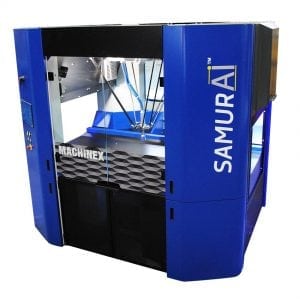 If you’re searching for a clear example of market pain spurring equipment investments, then look no further than the robot installed by Lakeshore Recycling Systems.
If you’re searching for a clear example of market pain spurring equipment investments, then look no further than the robot installed by Lakeshore Recycling Systems.
“The fiber markets falling apart in September really made us make this decision, ” said Alan Handley, CEO of Lakeshore, which serves the Chicago area.
In addition to embracing cutting-edge robotics, Lakeshore installed an optical sorter on its fiber line. Together, the technologies are helping the MRF maintain commodity sales revenues in a difficult fiber market and operate with fewer employees during a difficult labor market.
Robots are being used more and more around the country. Indeed, Lakeshore plans to install two more of them this year.
“I really do look forward to the day when basically most of my MRF is robotic,” Handley said. “Between opticals and robots, I think you can eliminate a lot of the human element from the traditional MRF.”
Robots a market reality
Crews installed the SamurAI robot at Lakeshore’s single-stream Heartland Recycling Center near Chicago in May. The company first announced the robot in late June.
The SamurAI unit was provided by Quebec-based recycling equipment company Machinex, which licenses the robot’s software brain from Denver company AMP Robotics. AMP developed software that allows a computer to recognize objects on the conveyor belt based on their visual appearance. The artificial intelligence aspect allows the computer to learn and improve its accuracy over time.
Other sorting robots with artificial intelligence have been rolled out into the marketplace, as well, including the Max-AI from Eugene, Ore.-based Bulk Handling Systems (BHS) and the ZenRobotics Recycler from Helsinki-based ZenRobotics.
This is the first SamurAI to be installed at a working facility since the Machinex-AMP partnership began (AMP previously installed robots in MRFs in Denver; Omaha, Neb. and Shakopee, Minn., and it’s still free to deploy robots outside the Machinex agreement).
The AMP-Machinex partnership was first announced in April, when Machinex displayed the robot at WasteExpo in Las Vegas. Machinex noted that a second unit is slated to be installed at a Canadian MRF, although that location hasn’t yet been announced.
Learning the stream
At Heartland, SamurAI is working on the container line immediately after the optical sorter separating PET. The robot uses a suction cup attached to a pedestal with four arms moving in a quadrant. At Heartland, SamurAI is programmed to pick HDPE natural, aluminum foil, HDPE color and aseptic cartons, in that priority order, Handley said.
In late July, when Resource Recycling spoke with him, Handley said SamurAI was achieving between 50 and 60 picks per minute, close to what a human can do. The accuracy was at about 85 percent. The facility runs two shifts per day.
The system is improving on a weekly basis, he said. For items it misses, Heartland staff put the system in learning mode and run the items back under the camera. That allows it to recognize items it needs to pick. Handley used the example of Dean’s brand milk cartons, which are common in that market. Additionally, it is connected to other AMP robots, allowing it to learn from their experience.
“I think we should get better progress and better flow as it gets smarter,” Handley said.
Following the robot on the line is an eddy current separator and a quality control staffer, who Handley described as a “safety stop” during SamurAI’s transition process. The goal is to get SamurAI’s accuracy into the 90 percent range; once it begins to hit accuracy and pick rate targets, the robot QC staffer won’t be needed. Handley predicts that’ll occur in the third quarter of this year.
According to Machinex, the robot can achieve up to 70 picks per minute and 95 percent accuracy.
Handley noted that the installation costs were minimal – certainly less than $50,000, he estimated – largely because the Heartland MRF is relatively new and already had the necessarily electrical hook-ups. The facility opened in 2016, aided by a $1.5 million low-interest loan from the Closed Loop Fund.
He wasn’t able to divulge the robot’s price, but he said Lakeshore is making monthly payments interest free until they decide it has met its commercial viability, at which point they’ll pay the remaining balance and own it.
Quality and cost benefits
Drops in paper and OCC values last fall persuaded Lakeshore to move forward on new sorting equipment, Handley said. To maintain the financial performance of the MRF, Handley said Lakeshore was faced with three scenarios: Wait for fiber prices to increase, install sorting equipment to “recharacterize” bales, or replace humans with fixed costs. The first scenario hasn’t materialized. Lakeshore took steps to realize the second and third scenarios. It installed an optical sorter to remove OCC from the mixed paper stream so the MRF could recharacterize and begin selling its “mixed paper” bales as “ONP” bales. It also installed the robotic unit.
The optical sorter increased OCC recovery dramatically, and the MRF was able to find an end market for a stream it was struggling to sell, he said. Additionally, the company was also able to reduce the employee count by eight people.
“In this market, where it is very difficult to find MRF workers at all, it’s one less thing I have to worry about, not to mention workers’ compensation, calling in sick and all of the other things that go on in that kind of labor pool,” he said.
Handley said he has already ordered two additional SamurAI units, which are supposed to arrive during the third quarter.
He envisions the emergence of near-fully automated MRFs within five years. “If you think about the demographics in this country and the labor issues we have in this country, … I think it’s going to get harder and harder to attract people to do this for a living,” he said.
More stories about MRFs
- WM outlines investments in recycling infrastructure
- Industry coalition focuses on small-format material recovery
- MRFs share how they develop accepted material lists



